Geckos can be found in warm climates around the world. The largest gecko, the New Caledonian Giant Gecko, is well over a foot long. The smallest, the Jaragua Gecko, can sleep comfortably on a dime.
There are over 1,500 species, and at least two dozen of those are sold in the pet industry.
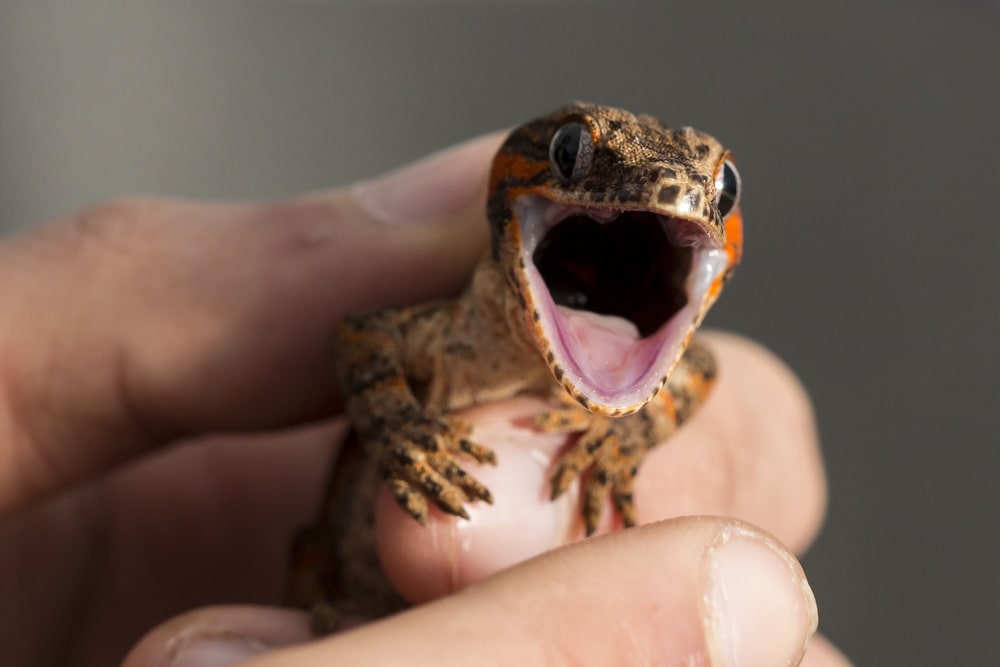
Those looking to get started with geckos may feel overwhelmed with all their choices. To help out, we have provided an introduction to eight geckos you may find when browsing at pet shops or reptile breeder sites. Read on to learn about geckos for keepers at all levels of experience.
Quick Navigation
Types of Geckos for Beginning Gecko Keepers
These geckos are easy to keep and can be handled occasionally so long as you are gentle.
That doesn’t mean you can stick them in a tank and forget about them. If you do not provide clean housing and appropriate food these geckos will suffer for your neglect. But these geckos can survive minor newbie errors and tolerate less-than-ideal conditions.
Leopard Gecko (Eublepharis macularius)
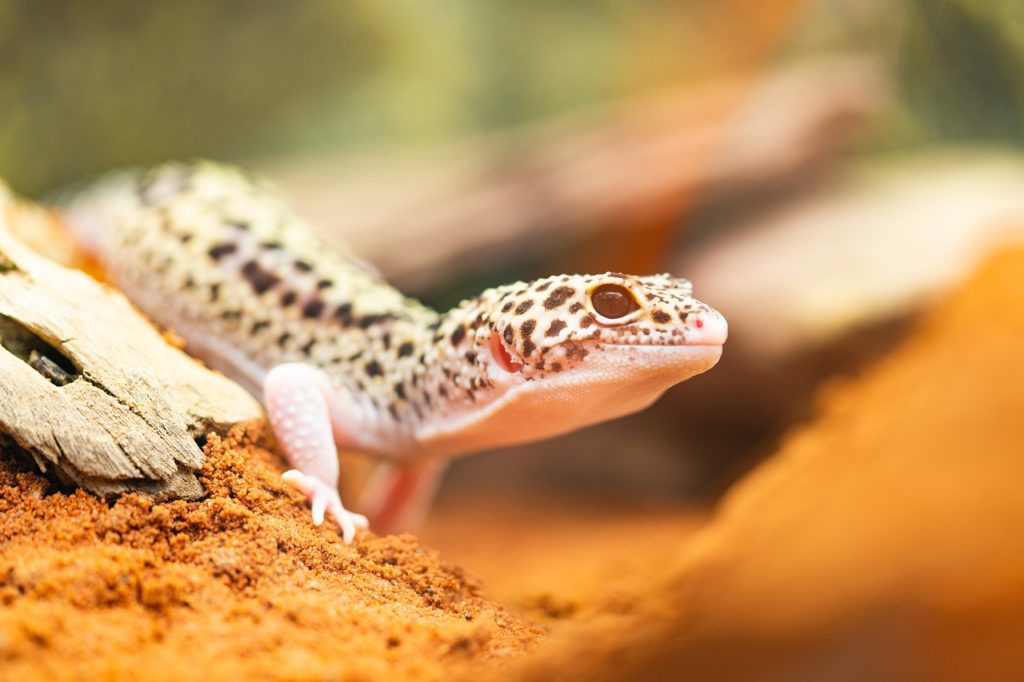
Originally found in the dry regions of Afghanistan, Pakistan, India, Nepal and Iran, today Leopard Geckos can be found all over the world. Leopard Geckos are the most commonly found geckos in the pet trade for many reasons.
In their native habitat, Leopard Geckos live in rocky dry grasslands and deserts. The rocks provide crevices for shelter. They burrow into the clay and sandy soils and hide from the sun and predators. When the sun goes down Leopards search for insects and anything else they can eat.
The Leopard Gecko gets its name from the spots on its yellow-orange body and the white belly which blushes up its sides. But today you can also find many Leopard Gecko morphs available in the pet market.
Unlike most geckos, Leopard Geckos have eyelids. They don’t have to lick their corneas to get rid of dust, they simply blink. But Leopards do not have the ridged toe pads which allow other geckos to climb trees or run up walls. This is good for beginning gecko keepers, as climbing geckos can be escape artists!
With their permanently curved mouths, Leopard Geckos always look happy. You can keep them happy by providing a clean 15 to 20-gallon tank with lots of hides, a warm spot between 87∞ and 90∞, a stable dish of fresh water, and a steady diet of gut-loaded and calcium dusted crickets and mealworms.
Crested Gecko (Correlophus ciliatus, formerly Rhacodactylus ciliatus)
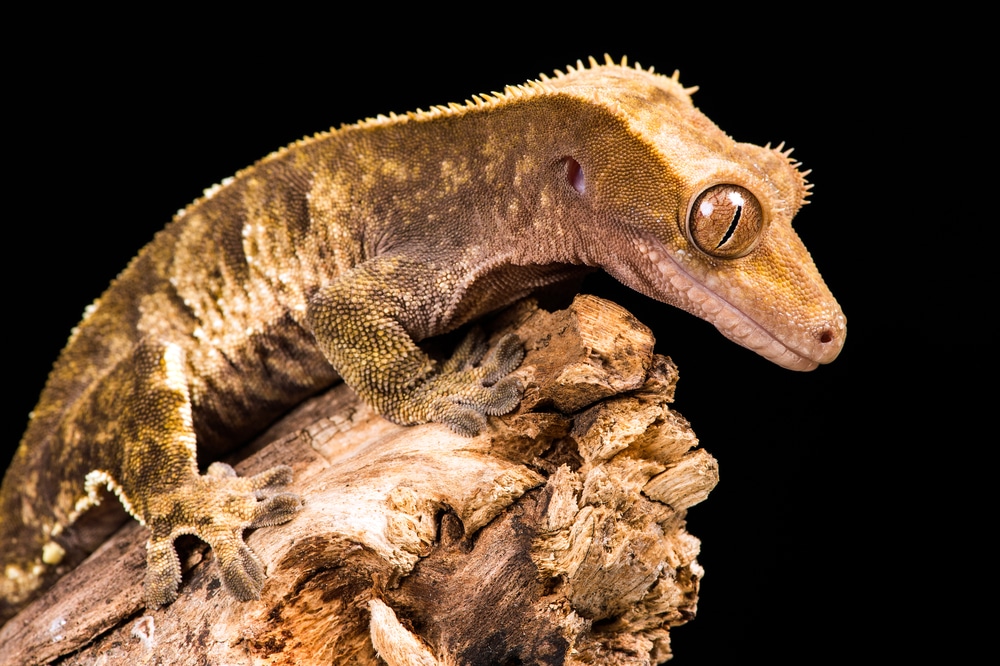
Until 1994 scientists believed New Caledonia’s Crested Gecko was extinct. Twenty-five years later Crested Geckos are among the most popular geckos in the trade. Spiky protuberances around their eyes have given them another common name, Eyelash Gecko. Many first-time gecko keepers buy Crested Geckos for their ease of care and generally docile disposition.
Captive bred Crested Geckos come in a variety of colors, from near-black to cream-white along with reds, yellows and the normal olive. Patterns include pinstripes, tiger stripes and spots. These have been mixed and matched by breeders and today you can get Crested Geckos with multiple morphs – though you may not get them cheaply!
Crested Geckos have modest heating requirements. A warm spot of 80∞ will suit them just fine: any higher and they will become stressed. They can handle temperatures as cold as 60∞ but will be more comfortable with a cool spot in the high 60s to low 70s. They will also appreciate a brief misting every evening with a water bottle, but don’t overdo it.
Crested Geckos need climbing branches, hides and a water dish. They also need a balanced diet of fruits, their primary diet in the wild. Pangea Banana-Papaya Fruit Mix and Repashy Crested Gecko MRP Diet are both recommended by many Crested Gecko breeders. Gut-loaded mealworms, crickets or waxworms are good as an occasional treat.
Because they like to climb, a tall terrarium will suit a Crested Gecko best. 24 inches x 18 inches x 18 inches is the minimum for adult Crested Geckos. You can go larger and your Crested will appreciate the extra space, but make sure you have hiding spaces where they can rest.
We have some articles that will assist you in setting up your Crested Gecko’s home.
African Fat-Tailed Gecko (Hemitheconyx caudicinctus)

At first glance African Fat-Tailed Geckos look like brown Leopard Geckos with more junk in the trunk. Like Leopards, African Fat-Tailed Geckos have eyelids and lack toe ridges for climbing. But while Leopard Geckos come from southern Central Asia, African Fat-Tails are found in the arid regions of West Africa between Cameroon and Senegal.
Though they are not yet quite so popular as Leopard Geckos, African Fat-Tails have many fans in the gecko keeping community. Most African Fat-Tails on the market are captive-bred. The original brown pattern is available, as are morphs like White-Outs, Striped, Banded, Ghosts and Stingers.
African Fat-Tail Geckos are even more tolerant of handling than Leopard Geckos. But whatever you do, never grab an African Fat-Tail – or any other gecko – by the tail. Gecko tails detach easily as a defense mechanism. While their tail will grow back it will be shorter and stubbier and the tail wound may become infected.
Because they are terrestrial geckos and lack climbing pads, you should use an under-tank heater or heating tape to provide them a 90∞ basking spot. Their cool side should be in the high 70s to low 80s. Give them a moist hiding area and lightly mist their habitat two or three times a week. African Fat-Tails are insectivorous and will thrive on the same diet as your Leopard Geckos.
That being said, do not try keeping African Fat-Tails and Leopards in the same tank. Leopards need drier conditions, and the docile African Fat-Tail will likely be wounded or killed by the more assertive Leopard Gecko.
Gargoyle Geckos (Rhacodactylus auriculatus)

New Caledonia’s Gargoyle Gecko gets its name from the tiny horns on its head. But while gargoyles are frightening, Gargoyle Geckos are gentle reptiles. They are easily bred in captivity and come both in their native brown-grey patterns and a number of morphs including red and yellow stripes.
Your Gargoyle Gecko needs at least a 20-gallon tank, but will happily live in a larger enclosure. If you live in a relatively humid area, a screen cage will provide your Gargoyle with both humidity and good ventilation.
Gargoyle Geckos prefer cooler temperatures than most geckos. They will do fine with a warm spot of between 78∞ to 82∞ provided by a low-wattage incandescent bulb, under tank heater with thermostat or ceramic heat emitter. In the summer you may need to move them to an air-conditioned room if their room’s ambient air temperature gets above 87∞.
Reptile carpet will provide an easily cleaned substrate. If you want to include live plants in their terrarium, make sure your soil does not include perlite. A 50/50 mix of soil and coir (coconut fiber sold in bricks like Zilla Coconut Husk Brick will be good for both your plants and your Gargoyle Gecko.
Gargoyle Geckos like climbing, so provide them with branches as well as ground-level hides. Leave plenty of open space to allow them room to explore. If you are interested in owning a Gargoyle Gecko, here is a handy care guide that will provide the care and feeding instructions you need to keep your Gargoyle safe and healthy.
Intermediate Level Geckos to Keep as Pets
These geckos will benefit from a keeper with some experience. They may have more specialized care requirements, or they may be less tolerant of handling. If you can meet those requirements you may find these geckos worth the effort.
Gold Dust Day Gecko (Phelsuma laticauda)
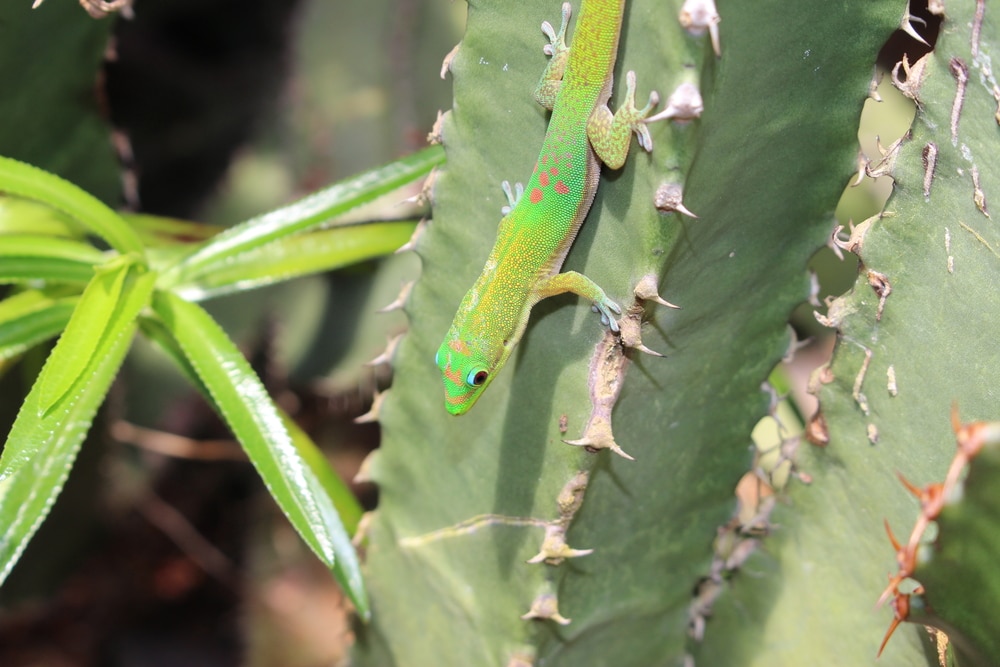
The Gold Dust Day Gecko gets its name from the tiny yellow dots dappled over its bright green skin. As adults they reach a length of six to nine inches. While they will breed in captivity, most Gold Dust Day Geckos in the pet trade are imported wild-caught animals.
Gold Dust Day Geckos comes from northern Madagascar and are accustomed to a humid tropical climate. They will benefit from a terrarium humidifier like the Zoo Med Reptifogger. Give them branches and lots of hiding spaces. Be sure to provide them plenty of light and a UVA/UVB lamp. Their basking area should be in the low 90s and their cool spot in the low to mid 70s.
Gold Dust Day Geckos are best kept one to a tank. They quarrel amongst each other and males will often wound or even kill a female introduced for breeding.
In the wild they live on a diet of insects and fruit nectar. In captivity feed them mealworms, crickets and mealworms along with Repashy Crested Gecko MRP Diet or another supplement for fruit-eating geckos.
Gold Dust Day Geckos are easily stressed and do not tolerate handling well. If you grab them too hard their skin may tear, or they may drop their tail to escape. This is a gecko best admired from the other side of the glass.
Madagascar Ground Gecko (Paroedura pictus)
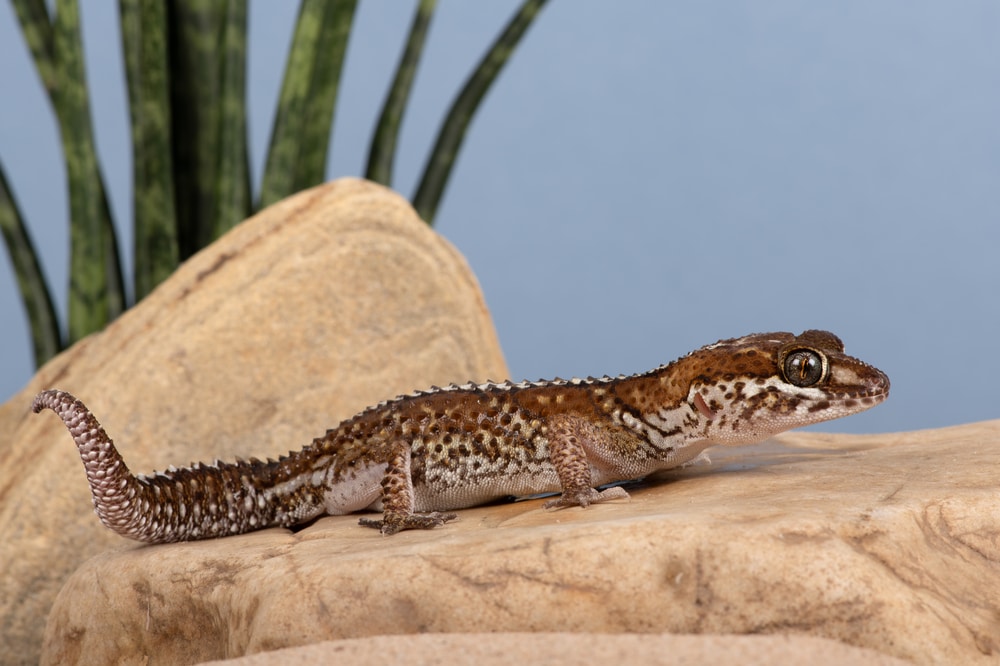
The Madagascar Ground Gecko comes from southern Madagascar. While wild-caught imports are occasionally found for sale, most Madagascar Ground Geckos in the pet trade are captive bred.
Available morphs include Hypo, Orange, Yellow, Anerythristic, Xanthic, Banded and Striped. Some stores and breeders sell Madagascar Ground Geckos as Panther Geckos, Ocelot Geckos or Malagasy Fat-Tailed Geckos.
Madagascar Ground Geckos are smaller than Leopard Geckos. Adults are typically between four and six inches from nose to tail, though a big male may reach eight inches. Unlike its fruit-eating northern neighbor, the Madagascar Ground Gecko is entirely insectivorous. They are healthy eaters who will pack away the crickets, roaches and mealworms.
Because they are nocturnal, Madagascar Ground Geckos require very little if any UV supplementation. Neither do they need a fogger, though a daily light misting with a spray bottle will help their sheds.
Keeping several hides in the enclosure will lead to a calmer Madagascar Ground Gecko. In their native home they hide under fallen leaves. And while Gold Dust Day Geckos need branches to thrive, P. pictus, as per the name, is happiest and safest on the ground.
They can climb (and you should keep a secure lid on their home) but will spend most of their time on the terrarium floor. If you give them branches to explore, make sure they are low to the ground. (Think logs or sticks rather than branches). A Madagascar Ground Gecko can be injured if it falls too far.
The Madagascar Ground Gecko is generally as easy to care for as a Leopard Gecko. But they are less tolerant of handling than a Leopard. They do not tolerate stress well and will often bite and sometimes shed their tail when you try picking them up.
In time some Madagascar Ground Geckos will tolerate brief handling from a trusted owner. But this will require patience and your gecko may always be skittish. If you are fine with watching your reptile from a distance, the Madagascar Ground Gecko makes an excellent pet.
Geckos for Advanced Gecko Keepers
These geckos offer special challenges. A novice may not be ready for their environmental needs or their temperament. You will do better keeping them after you have gained some reptile husbandry experience with less difficult species.
Tokay Gecko (Gekko gecko)
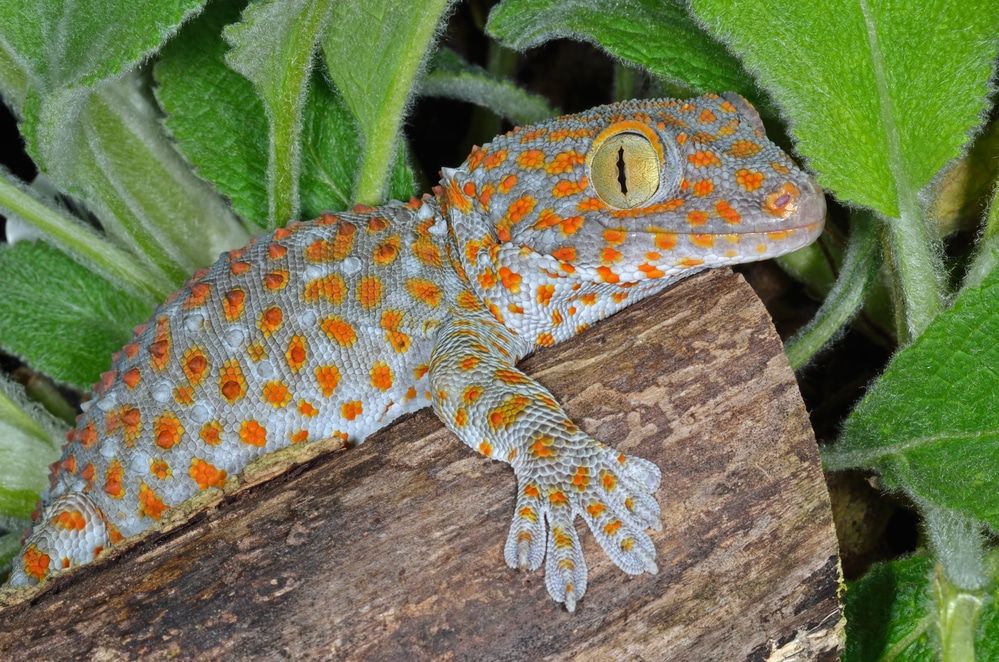
With their bright orange spots on a turquoise-grey background, Tokay Geckos command immediate attention. Tokays are also widely available in pet stores and can be purchased for $20 or less. You may be tempted to purchase one of these little beauties as your first gecko.
But the Tokay Gecko’s pretty colors mask its foul disposition. Tokays are highly territorial and will lunge at your hand when it enters their tank. And after your Tokay has bitten you, it won’t hesitate to make a dash for escape.
(Did I mention that Tokays are also very fast runners? Or that they can run up walls to get behind dressers or appliances?)
Some baby geckos are nippy as hatchlings but calm down with patient and gentle handling. Your Tokay Gecko will always be a biter. Tokays are one of the largest gecko species, with males reaching 13-16 inches and females 8-12. Those bites that hurt when your Tokay was a baby will draw blood once they grow up.
Tokay Geckos are found throughout Southeast Asia. Inspired by the Tokay’s noisy call, people throughout the region call them token, gekk-gekk, tuck-too or poo-kay. American soldiers in Vietnam, inspired by it call and disposition, called it the “____ you lizard.”
Once you get past the teeth, Tokays are not especially difficult to keep. Give them a diet of leafy greens, fruit and insects and an 80∞ to 85∞ cage with a warm spot between 90∞ and 105∞. Mist their tank nightly (or use a dripper or fogger) and provide supplemental UVA/UVB light.
Leucistic, Calico, Powder Blue and Granite are a few of the available Tokay Gecko morphs. If you are experienced in chasing down runaway geckos and aren’t afraid of an occasional bite, you should have little trouble finding the perfect Tokay Gecko for your collection.
Flying Gecko (Gekko kuhli, formerly Ptychozoon kuhli)
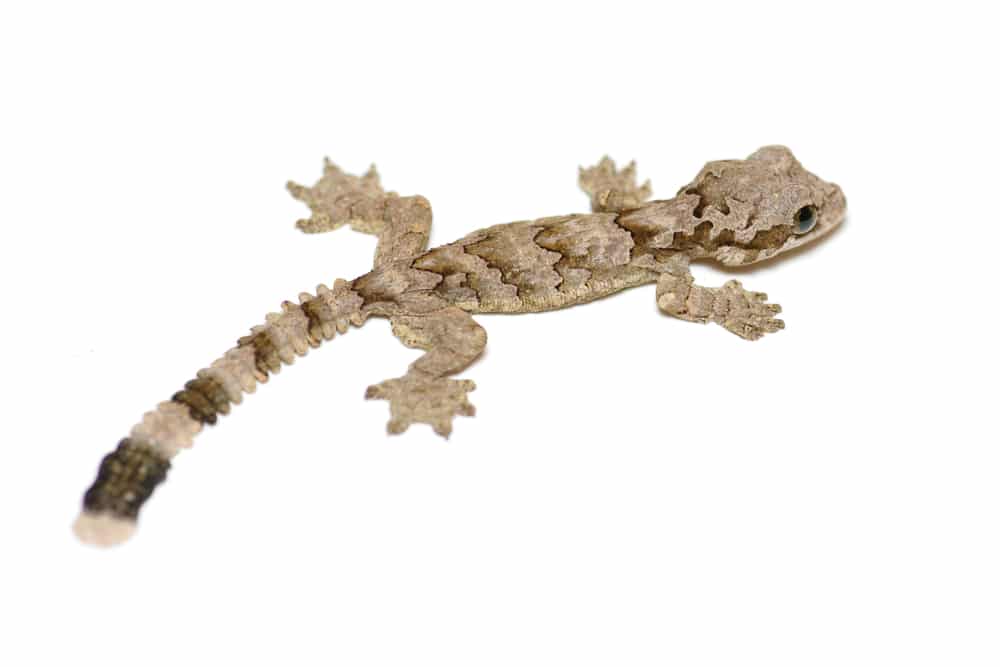
If you were walking through a Southeast Asian rain forest you would probably never spot a Flying Gecko. At a quick glance their loose mottled brown skin makes them look like a dead leaf or a piece of bark.
If you were very lucky you might see a small brown lizard leap from one branch and sail to another. Their loose skin allows Flying Geckos to glide like a flying squirrel or sugar glider, a skill which gives them their name.
Flying Geckos need good-sized cages, which should be taller than they are wide. They also need branches to climb and foliage to hide under. The bigger the space you can provide, the better. Flying Geckos are active after dark and will spend much of the night exploring. If you can keep them in a large enough terrarium you may even get to see them sailing between branches.
Rainforests are humid, and your Flying Geckos will benefit from a reptile fogger or a dripper like a Exo Terra Dripper Plant. But too much humidity can lead to scale rot and respiratory infections. The humidity should be 80% at night and no less than 60% during the day. Use a heat lamp to provide a 95∞ basking spot.
Flying geckos will enjoy a Feeding Ledge, as they will feel more comfortable eating their crickets, roaches, mealworms and waxworms from a branch. In the wild Flying Geckos are more vulnerable to predators on the ground and spend most of their time in the trees.
Flying Geckos do not like handling and their thin skin is easily damaged. Given their specialized humidity requirements, preference for larger containers, and skittish nature, Flying Geckos are best left to keepers with gecko keeping experience.
Conclusion
If you are interested in any of these geckos, do some research into their requirements. Find a reputable breeder. Gecko Forums and Geckos Unlimited will put you in touch with breeders and advanced hobbyists. They can answer any questions you may have on your new pet and set you on the way to years of happy gecko keeping!